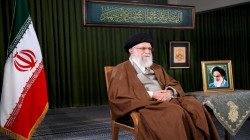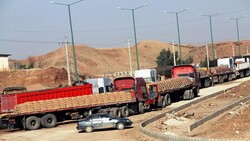Iran-backed militias' attacks against U.S. targets are up. The U.S. hasn't responded with force since last year.

Shafaq News/ Attacks by Iranian proxies against bases housing U.S. military personnel in Iraq and Syria are increasing, U.S. officials say, and Washington has not responded with force since 2021.
There were seven attacks in May, as many attacks that month as February, March and April combined, and there have been a total of 29 since October without a kinetic U.S. response.
No Americans have been killed in these incidents, but a U.S. intelligence assessment found Iran may believe its proxy groups have killed and injured Americans, according to two U.S. officials familiar with the assessment. Iranians often boast about battlefield successes that are not substantiated. Earlier this year, Iranian officials claimed to have killed Israelis at a safe house in Irbil, which turned out to be untrue.
The attacks have been carried out by Iranian-backed militias, the U.S. officials say.
In a statement, the White House National Security Council said, “There is nothing that President Biden takes more seriously than the security of U.S. personnel deployed overseas. Shortly before we entered office, U.S. personnel and facilities were under regular attack in Iraq and Syria. This included the largest rocket attack against our embassy in Baghdad in over a decade, which took place in late 2020. We immediately deployed a number of tools, including military strikes, diplomatic engagement, sanctions, and other measures to both protect our personnel and decrease risks of further attacks. The spate of attacks has decreased significantly since the middle of last year.”
“Not every response will be seen or visible, but Iran fully understands that the United States is prepared to respond directly to any threat against U.S. personnel.”
The Trump administration made clear it would respond if Americans were injured or killed in an attack, but the Biden administration has not drawn a similar red line for retaliation and a possible response would not be contingent on a U.S. casualty.
Michael Knights of the Washington Institute for Near East Policy, who follows the militias closely, says “there’s been an increase” since April in attacks that appeared to be designed to send a warning.
The impetus for the uptick in attacks was likely the stalled negotiations on the 2015 nuclear deal and signals from Washington that it may increase economic pressure on Tehran if the talks completely collapse, he said. He believes the attacks are meant to send a message to Washington that more pressure on Iran will trigger more attacks on U.S. troops in Iraq and Syria.
“A lot of this stuff seems to be in the manner of a warning, like — ‘We’re coming. We’re warming up. This is what we could do if we wanted to. [T]hey’re reminding us that they could [kill us],’” Knights said.
“I think it’s an indication that they are warming up their capabilities and they’re showing us that they are warming up their capabilities.”
When contacted by NBC News, Iran’s U.N. mission said it had no role in incidents in Iraq or Syria.
“We do not interfere in the internal affairs of other countries and therefore are not responsible for what is happening there,” said Shahrokh Nazemi, spokesperson for Iran’s mission to the United Nations.
He added that events in Iraq or Syria had no connection to the 2015 nuclear deal, known as the JCPOA.
“The developments in the region have nothing to do with the JCPOA,” the spokesperson said, adding the U.S. “must honor its commitments” under the nuclear deal.
In October 2021, five so-called suicide drones packed with explosives and shrapnel attacked the U.S. garrison at al-Tanf in southern Syria. No U.S. troops were killed in the assault, but several structures were badly damaged. Iran was behind the attack, according to three U.S. defense officials and two administration officials, with its proxy forces carrying out the attack with the intention of killing U.S. troops.
Iran launched the attack in retaliation for an Israeli strike targeting advanced missiles parts in Syria that killed and wounded Iranian citizens, the U.S. officials said. The U.S. military had a warning that the drones were inbound and was able to move most of the 200 U.S. troops away from the base, which the officials said may have been the only reason no troops were injured or killed.
After the al-Tanf attack, the U.S. sent a message to Iran through diplomatic channels, warning it not to strike again. Since then, U.S. troops have been attacked on at least 29 separate occasions, according to a list provided by a senior defense official. The most recent attack was last week when an Iranian-backed group fired five Katyusha rockets into al-Asad air base in western Iraq.
The Biden administration carried out airstrikes in Syria in February 2021 in retaliation for rocket attacks, and against Iraqi militia targets in June 2021 in response to drone attacks, but has not retaliated against Iranian proxies for any attack since al-Tanf.
The Biden administration has told the Iranian regime it holds Tehran responsible for attacks from militia groups in Iraq and Syria and officials insist Iran knows that the U.S., from President Joe Biden to the U.S. military, is fully prepared to respond.
Officials also insist that just because the U.S. is not responding with airstrikes does not mean it is ignoring the attacks.
The Iranian-backed groups may be trying to draw the U.S. into a situation that could escalate, and some Biden administration officials argue it is smarter to work with the Iraqi military, focus on diplomatic messaging or consider sanctions. The U.S. shares intelligence with the Iraqis and their counterterror forces have been effective in hunting down militia groups after attacks.
Most of the recent attacks have been ineffective or easily defeated, and the Biden administration takes the scale of the attack into account before deciding on a possible response.
The Biden administration has not seen any indication that Iran's Revolutionary Guard has made a decision to escalate attacks against the U.S. in Iraq or Syria, but officials warn that could change and a significant escalation against the U.S. could close the door to a new nuclear agreement.
Most of the attacks were carried out by indirect fire, but U.S. officials are concerned about the increasing number of unmanned one-way drones, often referred to as suicide drones. There was also a probable SA-6 surface-to-air missile attack on two U.S. F-16s in Dayr az Zawr, Syria, that has not been disclosed.
After the al-Tanf attack, the Biden administration called for options to respond. Within hours, the commander of U.S. Central Command at the time, Gen. Frank McKenzie, briefed Secretary of Defense Lloyd Austin on options to retaliate, which included airstrikes in Iran that could lead to the deaths of Iranians.
White House officials bristled at the possibility of Iranians being killed and called for more options. After several rounds of possibilities presented, the Biden administration decided on a diplomatic message rather than a military response, angering some U.S. military leaders who wanted to respond with strikes. A U.S. military response against Iran would require White House approval.
If clear approval to conduct a retaliatory strike does not come within 72 hours of the original attack, the strike is very unlikely to happen, according to U.S. military statistics, which show that to be true of every strike against Iran since 2007.
The more the White House and the National Security Council ask for various options, the less likely the U.S. is to do anything kinetic, the statistics and U.S. military officials say.
One U.S. military official described the situation between the U.S. and Iran as being on “an escalation ladder,” citing the assassination of a senior Quds Force leader in Tehran, Iran’s seizure of two Greek oil tankers, and Israel’s recent military exercise simulating strikes on Iran.
Source: NBC News





